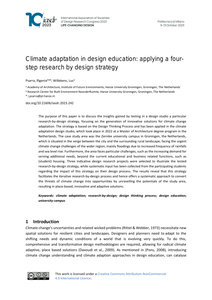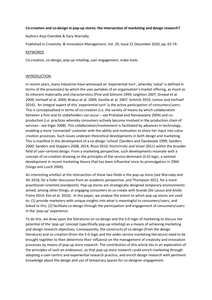Showing the results of the project Revealing design (Zichtbaar slimmer): Data physicalization for the 21st Century
LINK
In this paper we explore the influence of the physical and social environment (the design space) son the formation of shared understanding in multidisciplinary design teams. We concentrate on the creative design meeting as a microenvironment for studying processes of design communication. Our applied research context entails the design of mixed physical–digital interactive systems supporting design meetings. Informed by theories of embodiment that have recently gained interest in cognitive science, we focus on the role of interactive “traces,” representational artifacts both created and used by participants as scaffolds for creating shared understanding. Our research through design approach resulted in two prototypes that form two concrete proposals of how the environment may scaffold shared understanding in design meetings. In several user studies we observed users working with our systems in natural contexts. Our analysis reveals how an ensemble of ongoing social as well as physical interactions, scaffolded by the interactive environment, grounds the formation of shared understanding in teams. We discuss implications for designing collaborative tools and for design communication theory in general.
MULTIFILE

The purpose of this paper is to discuss the insights gained by testing in a design studio a particular research-by-design strategy, focusing on the generation of innovative solutions for climate change adaptation. The strategy is based on the Design Thinking Process and has been applied in the climate adaptation design studio, which took place in 2022 at a Master of Architecture degree program in the Netherlands. The case study area was the Zernike university campus in Groningen, the Netherlands, which is situated in the verge between the city and the surrounding rural landscape, facing the urgent climate change challenges of the wider region, mainly floodings due to increased frequency of rainfalls and sea level rise. Furthermore, the area faces particular challenges, such as the increasing demand for serving additional needs, beyond the current educational and business related functions, such as (student) housing. Three indicative design research projects were selected to illustrate the tested research-by-design strategy, while systematic input has been collected from the participating students regarding the impact of this strategy on their design process. The results reveal that this strategy facilitates the iterative research-by-design process and hence offers a systematic approach to convert the threats of climate change into opportunities by unravelling the potentials of the study area, resulting in place-based, innovative and adaptive solutions.
DOCUMENT

Co-creation as a concept and process has been prominent in both marketing and design research over the past ten years. Referring respectively to the active collaboration of firms with their stakeholders in value creation, or to the participation of design users in the design research process, there has arguably been little common discourse between these academic disciplines. This article seeks to redress this deficiency by connecting marketing and design research together—and particularly the concepts of co-creation and co-design—to advance theory and broaden the scope of applied research into the topic. It does this by elaborating the notion of the pop-up store as temporary place of consumer/user engagement, to build common ground for theory and experimentation in terms of allowing marketers insight into what is meaningful to consumers and in terms of facilitating co-design. The article describes two case studies, which outline how this can occur and concludes by proposing principles and an agenda for future marketing/design pop-up research. This is the peer reviewed version of the following article: Overdiek A. & Warnaby G. (2020), "Co-creation and co-design in pop-up stores: the intersection of marketing and design research?", Creativity & Innovation Management, Vol. 29, Issue S1, pp. 63-74, which has been published in final form at https://doi.org/10.1111/caim.12373. This article may be used for non-commercial purposes in accordance with Wiley Terms and Conditions for Use of Self-Archived Versions. LinkedIn: https://nl.linkedin.com/in/overdiek12345
MULTIFILE

Efforts to create age-friendly cities progressively intersect with goals for environmental sustainability. The older people’s beliefs, behaviours and financial aspects regarding environmental sustainability in their lives are an understudied topic and not well understood. Therefore, a representative survey was conducted using the psychometrically sound and comprehensive SustainABLE-16 Questionnaire. A total of 388 respondents, who were community-dwelling older people in The Hague, filled out the survey completely. Overall, the mean scores on the SustainABLE-16 for finance- and environment-driven pro-environmental behaviours, beliefs and the financial position among older people were positive for all districts of The Hague. Using the outcomes of the survey, a total of six unique typologies were identified through a two-step process combining hierarchical and k-means cluster analyses. These six typologies are 1 the staunch non-believers, 2 the finance-driven non-believers, 3 the everyday individuals, 4 belief-driven people with limited financial resources, 5 believing non-responders, 6 the affluent and engaging people. These six typologies each require different approaches from policymakers. Sustainabilityrelated policies should ideally focus on groups with high scores for pro-environmental behaviours but who have shortcomings in knowledge how to improve one’s everyday lifestyle and groups who lack the necessary financial means to live a more sustainable life.
MULTIFILE

How and where can Dutch design entrepreneurs find work in Germany? This was the question DutchDFA put to the research team at Inholland University of Applied Sciences in February 2010. But the researchers took a different angle, and generated unexpected data, revealing patterns, and valuable new insights into practicing design and architecture abroad.
DOCUMENT

Service design is literally the design of services. Service designers improve existing services or design completely new ones. Nothing new so far. Services have been around for centuries, and every service was conceived and designed by someone. However, service design takes a different angle; a different perspective as its starting point: it is a process of creative inquiry aimed at the experiences of the individual user. ‘Service design, insights from 9 case studies’ is the final publication of the Innovation in Services programme. During this programme, creative design agencies applied the methods of service design in nine different projects.
DOCUMENT

The transition to an inclusive society through design Inclusive design can play a critical role in shaping a more equitable society. When products and services are intentionally created to be inclusive, they become more accessible to a wide audience, including people who might otherwise struggle to engage with them. In this way, designers become agents of social transformation. The project Active Inclusive Design (AID) addresses this challenge directly. It aims to enhance the capabilities of professional and future designers to create inclusive products and services, both digital and non-digital. In doing so, it supports a responsible and digital society central to the Expertise network Systemic Co-design (ESC) agenda, and is closely connected to all ESC Dynamic Learning Agenda (DLA) themes: Systemic Co-Design (SCD) in me, SCD with others, SCD in reality and SCD in time.
LINK
Office well-being aims to explore and support a healthy, balanced and active work style in office environments. Recent work on tangible user interfaces has started to explore the role of physical, tangible interfaces as active interventions to explore how to tackle problems such as inactive work and lifestyles, and increasingly sedentary behaviours. We identify a fragmented research landscape on tangible Office well-being interventions, missing the relationship between interventions, data, design strategies, and outcomes, and behaviour change techniques. Based on the analysis of 40 papers, we identify 7 classifications in tangible Office well-being interventions and analyse the intervention based on their role and foundation in behaviour change. Based on the analysis, we present design considerations for the development of future tangible Office well-being design interventions and present an overview of the current field and future research into tangible Office well-being interventions to design for a healthier and active office environment.
DOCUMENT

The paper arguments that a design approach will be essential to the future of e-democracy and e-governance. This development is driven at the intersection of three fields: democracy, information technology and design. Developments in these fields will result in a new scale, new complexity and demands for new quality of democracy solutions. Design is essential to answer these new challenges. The article identifies a new generation of design thinking as a distinct new voice in the development of e-democracy and describes some of the consequences for democracy and governance. It argues that, to be able to design new solutions for e-democracy successfully, current approaches may be too narrow and a broader critical reflection is necessary for both designers and other stakeholders in the process.
DOCUMENT
